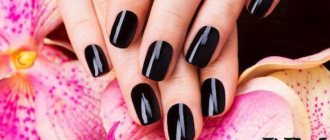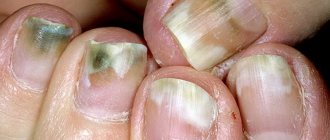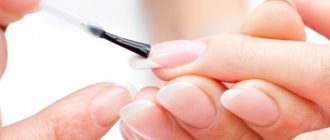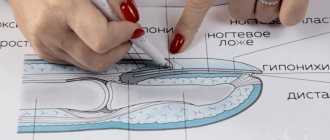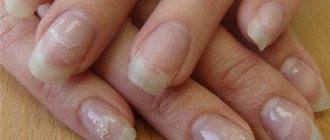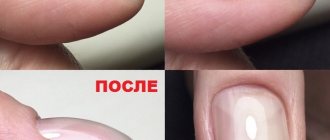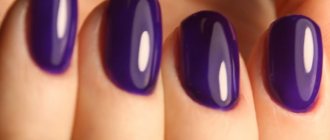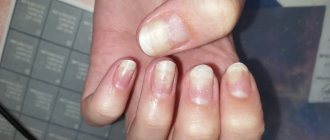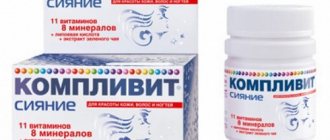What happens during onycholysis?
Onycholysis-detachment of the nail plate
Detachment is a violation of the integrity of the nail plates. form under their surface , which causes the nails to separate from the soft tissues of the fingers.
There is a complete or partial change in the color of the nail plates. They may become pale yellow, whitish-gray, or less commonly bluish or brown. At first, the upper part of the nail or its sides are peeled off as the disease develops , the defect reaches its base - the entire surface moves away from the nail bed. But more often than not, it doesn’t come to this, and the nail plate is not completely separated.
Medications
The main therapy for some diseases, when detachment of the nail from the nail bed occurs, is the use of drugs. Only a doctor can correctly prescribe treatment. Oral forms and ointments with the active substance are used. There are the following areas of medical assistance:
- Antimycotic agents based on: fluconazole;
- ketoconazole;
- terbinafine;
- intraconazole;
- griseofulvin.
In most cases, the nail detaches from the skin on the hand due to a fungal disease. Even if the pathology was previously treated, it requires long-term therapy for 3-12 months. If nail fungus is detected, the course is continued until the signs of delamination disappear and a healthy nail plate is formed. In order for the infection to be treated quickly and effectively, treatment cannot be interrupted.
- Antibacterial drugs - prescribed when purulent processes appear.
- Complexes containing calcium, iron, vitamins A, B, E - prevent peeling of the nail, it is recommended in any treatment conditions, taking into account the deficiency of useful components.
- Application of medicinal varnish with fungal substances. They are applied to the base and free part during manicure of the nail plate. It not only destroys the fungus, but also heals the nail that has peeled off. Under such treatment conditions, pathogenic flora does not multiply and the situation can be easily corrected.
Possible diseases due to nail detachment
Detachment of the nail plate can occur in some diseases, both chronic and acute. The most common are:
|
These are systemic diseases. Onycholysis is also characteristic of:
|
Prevention of nail detachment after injury
To avoid nail detachment after injury, you must perform the following steps:
- The peeling part of the nail must be cut off with sterile tweezers.
- Wipe the surface of the plate and the soft tissue near it with an antiseptic (Chlorhexidine, Iodine).
- Make a bath with sea salt and tea tree oil.
- Wipe the nail plate so that it is dry.
- Apply a drug that has a regenerating effect, for example, Bepanten, to the injured nail.
For prevention, these actions should be performed for 3-4 days.
Causes of onycholysis
The causes of detachment of the nail plate can be various factors of both infectious and non-infectious nature.
chemical factor for nail peeling
Non-infectious causes:
- Chemical – the disease manifests itself through frequent contact with household chemicals without the use of gloves or other substances. Such a product may be washing powder, nail polish, or nail polish remover.
- Mechanical – various injuries: strong blow, cutting, squeezing, habit of biting nails. In such cases, a hematoma (collection of blood) forms under the nail, which must be properly removed as soon as possible.
- Allergy. The same household products, latex, and nail polish can cause such a reaction. Often their peeling can be observed after coating with gel polish, which is popular today, but often causes allergies.
- Medications . This includes some groups of antibacterial drugs; the most common cause of nail splitting is treatment with fluoroquinolones.
- Manicures and pedicures performed incorrectly at home are also a common cause of onycholysis. Nails can begin to peel if you cut them carelessly, which leads to deformation, and when filing them, hold the file not perpendicular to the nail plate, but at an angle, and move the tool in different directions.
Onycholysis can be triggered by hormonal fluctuations, lack of vitamins and stressful situations.
Infectious causes include fungi, less commonly bacteria. In 40% of cases of the disease, onycholysis is caused by the first microorganisms. When they get on the nail plates, they destroy it, the nails begin to delaminate and break.
Treatment of onycholysis
Many people put off visiting a doctor, prefer to seek help from nail specialists, or self-medicate. Meanwhile, onycholysis therapy should begin as early as possible. If the pathology persists for more than one year, in most cases it is not possible to completely get rid of it.
Late seeking medical help is the main reason for the low effectiveness of treatment. According to statistics, complete relief from onycholysis is observed in no more than 30% of cases.
To effectively treat onycholysis, it is necessary to identify the cause and eliminate it. Diseases of the digestive and endocrine systems require active therapy. To protect the nail when in contact with water and household chemicals, it is recommended to use gloves.
How to care for an injured nail
In case of partial onycholysis of traumatic origin, it is necessary to regularly cut off the area of the exfoliated nail.
- Before the procedure, be sure to treat your fingers and scissors with a disinfectant, such as ethyl alcohol or chlorhexidine solution.
- To prevent bacterial microflora from entering the “pocket,” seal your nail with a special adhesive plaster with antibacterial impregnation.
For mycoses, antifungal drugs must be prescribed. They can be used both locally (in the form of sprays, solutions, ointments) and systemically - in tablet form for oral administration.
Surgical treatment is indicated for significant area of detachment of the nail plate. It is performed on an outpatient basis under local anesthesia. During the operation, the surgeon removes the hematoma and accumulations of contaminants from the subungual “pocket”. After this, a bandage with antiseptic or antibacterial ointment is applied to the wound. To restore the nail, it is necessary to use gelatin solutions for a long time. For better nail growth, your doctor may prescribe a vitamin and mineral complex.
Lack of vitamins
Deficiency of vitamins and various macro- and microelements can also provoke detachment of the nail plate. Their deficiency usually occurs when eating poor food.
The diet must contain foods high in iron, calcium, and zinc . large amounts of magnesium, vitamin D, and phosphorus is ideal , without which calcium absorption is impossible.
B, A and E , found in apples, butter and sunflower oil, seeds, dairy products, and nuts, are also important for healthy nails
Also in the diet there should be the presence of protein products, vegetables and fruits containing silicon, amino acids, zinc and folic acid.
Treatment
Treatment may be:
- traditional (using medications);
- using folk remedies.
To choose therapy, you need to know exactly what caused the nails to peel off. For example, if the cause is a bacterial infection, antibiotics are prescribed; for a fungus, antifungal drugs are used.
Use of medications
Medications for nail detachment are used in the form of ointments, solutions and tablets.
The following groups of drugs are used in treatment:
- antifungal agents (Fluconazole, Lamisil, Batrafen, Lotseril);
- antibacterial drugs (Levomekol, Vishnevsky ointment);
- angioprotectors;
- medications that improve blood circulation (Solcoseryl).
It is necessary to consume vitamin and mineral complexes.
ethnoscience
Folk remedies are effective for pathology. They are used as auxiliary drugs in combination with medications.
The most popular include:
- olive and sea buckthorn oil for rubbing into nails;
- Kombucha lotions;
- compress based on aloe juice;
- lubricating nails with a mixture of orange juice, iodine, water and salt;
Baths
Hand baths help with peeling nails.
Treatments based on the following ingredients are considered effective:
- sea salt (2 tbsp) and warm water (1 l);
- infusion of pine needles;
- infusion of calamus roots;
- decoctions of calendula, chamomile, string;
- lemon juice (1 tbsp), olive oil (2 tbsp), water (1 l);
- gelatin (0.5 tbsp) and warm water (1 l).
Hands should be immersed in these solutions for 15-20 minutes daily. The course of treatment is from 2 weeks to 1 month.
Treatment for complete nail detachment
There are many drugs that are used for complete detachment of the nail plate.
- Hydrogen peroxide;
- Chlorhexidine;
- Syntomycin ointment;
- Vishnevsky ointment;
- Furacilin;
- Iodine;
- Levomekol.
If the entire nail peels off, an experienced specialist will advise how to treat the wound.
Surgical methods
In some cases, when the nail completely separates from the bed, it may need to be removed through surgery.
Laser treatment can also be used.
Diagnosis of onycholysis
examination by a dermatologist
If you notice detachment of the nail plate, you should contact a dermatologist to determine the cause of this problem. If during the diagnostic process the doctor discovers concomitant diseases, he will refer the patient to another specialist . This is necessary in order to eliminate the factors that provoke onycholysis.
At the first appointment, the dermatologist visually examines the nail plates. It happens that the doctor immediately recognizes a fungal infection of the nails and refers the patient for an analysis (scraping), which reveals the type of pathogen. After this, appropriate treatment is prescribed.
If examination of the nails does not reveal the cause of their detachment, diagnostic methods such as:
- taking samples to determine the presence of fungus, staphylococci and streptococci;
- a blood test to assess the general condition of the body.
Other instrumental and laboratory diagnostics are also possible, the choice of which is based on the most likely cause of onycholysis.
Diagnostics
An important diagnostic sign that indicates disturbances in nail growth due to diseases of the endocrine or digestive system, as well as possible frequent injury, is the presence of Bo lines. They are arcuate lines that go from one side edge of the plate to the other¹.
Considering that the development of onycholysis in many cases is associated with a fungal infection, a scraping must be taken for subsequent microscopic examination.
The doctor takes a scraping for nail fungus. Photo: skvalval / Depositphotos
Differential diagnosis of onycholysis is carried out with some other diseases:
- mycoses - fungal infections;
- psoriasis is a chronic autoimmune inflammatory disease that primarily affects the skin;
- Bowen's disease is a rare dermatological disease that experts regard as a precancerous pathology;
- Lichen planus is an inflammatory disease of the skin and its appendages (nails, hair), which occurs with a variety of clinical symptoms.
Clinical picture
Symptoms of onycholysis depend on the cause that caused it.
In case of a disease that occurs after a nail injury, the following may occur:
- pain syndrome;
- hematoma formation;
- discoloration and weakening of the nail plate;
- bleeding.
If onycholysis is caused by an infection, you may experience:
- thickening of the nail plate;
- change in nail color, it becomes green or yellow;
- redness of the tissue around the nail plate;
- feeling of pain;
- unpleasant odor;
- discharge from under the nail plate.
Symptoms common to all types of onycholysis:
- the nail plate changes color, first stratifies in its upper part;
- unevenness, change in the border line dividing the nail plate into pink and white parts;
- the skin under the nail thickens;
- pain occurs only with secondary infection, due to microorganisms getting under the detached nail plate.
First aid for a nail injury
Hematoma-bruised nail
to place your hand or foot under a stream of cold water as quickly as possible . This is necessary to prevent the appearance of a hematoma under the nail , which provokes detachment of the nail plate. The injured limb should be kept in the cold for at least 15 minutes to constrict the blood vessels and eliminate pain.
To avoid swelling, an iodine mesh is applied to the skin and a tightening bandage is applied. This will minimize the risk of the nail moving away from the nail bed.
puncture to release blood from a hematoma
If a hematoma has formed, you should consult a doctor for a minor surgical intervention: a small hole is made in the nail so that the blood that has accumulated under it can come out.
If it is impossible to visit a specialist, you can try to carry out these manipulations at home under the condition of complete sterility . To do this, you need to thoroughly wash your hands and treat the bruise with an antiseptic solution, take a sterile needle, and heat it over a fire. After making a hole in the nail plate, remove the blood from under it. Then re-treat the nail.
The nail is coming off
- The nail hurts
- Calluses
- Nail deformities
- Corns
- Ingrown nail
- Crack on the foot
- Nail fungus
- Diabetic foot
- The nail has turned yellow
- SMART pedicure
Fingernails and toenails are exposed to aggressive environmental influences, as a result of which they can become deformed, break, change color, etc. Patients often come to our clinic with one complaint - the nail comes off (in medical parlance it is called onycholysis). At the initial consultation with a podiatrist, the main factors that could provoke this problem are identified, after which the specialist offers possible solutions.
Causes
Removal of the nail may be due to the following reasons:
- long-term antibiotic therapy (especially the tetracycline group);
- injury (as a result of a bruise or an incorrectly performed manicure/pedicure, for example, when removing gel polish too deeply, with damage to the surface layer of the nail plate);
- ingrown nail (if an inflammatory process has begun in the periungual tissues, the nail may peel off);
- fungus (mycoses lead to various kinds of deformations, including the possibility of plate separation);
- dermatopathology (psoriasis, dermatitis, eczema and others).
The functioning of the internal systems of the body, in particular the gastrointestinal tract, heart and blood vessels, has a great influence on the condition of the nails. Nervous breakdowns and an unstable psycho-emotional state can lead to onycholysis. Deficiency of vitamins and minerals also causes fragility, brittleness and peeling of nails.
Clinical picture
Depending on the reasons, it happens that the nail comes off completely, exposing the nail bed, or only at the edge. Taking this into account, the clinical picture may include symptoms such as:
- pain;
- change in the color of the nail (when an infection develops, it often turns yellow; in case of injury, a hematoma forms under the nail, as a result of which it looks blue, purple, etc.);
- stripes, spots on nails (mostly white);
- bleeding (typical of injuries);
- discharge of pus (when the plate grows into soft tissue);
- redness of the periungual fold (observed during inflammation).
Symptoms may complement each other. If the separation of the nail is associated with a skin pathology, rashes in the affected area in the form of blisters, blisters, spots and other markers of dermatosis are possible.
Diagnostics
The diagnosis is carried out by our specialist. In most cases, a visual examination is sufficient, but in controversial situations, laboratory tests are prescribed to make an accurate diagnosis (skin and nail scrapings are taken, blood tests are taken, etc.). Based on the results of the examination, therapy is prescribed.
Treatment
When a nail comes off, treatment measures are aimed at eliminating the causes that led to this problem:
- for fungal infections, antifungal drugs
, and the deformed nail plate is treated as part of a professional manicure or medical pedicure; - if an ingrown nail occurs with its subsequent removal, orthonyxia ( prosthetics using special plates
) will help; - It is possible to restore a nail after an injury using products with a wound-healing effect
such as “Panthenol” and “Bepanten”; blood clots under the plate are removed surgically in compliance with aseptic and antiseptic conditions; - skin diseases that provoke nail detachment require complex therapy
.
Our podiatrist develops an individual treatment regimen that allows you to get rid of nail problems in a short time!
Treatment with folk remedies
Alternative medicine methods are used as additional methods for symptomatic treatment and disinfection.
orange juice with salt
A good remedy for strengthening nails is a solution of orange juice, a tablespoon of salt and 60 ml of warm mineral water. 5 drops of iodine are added to these components. Everything gets mixed up. Keep your fingers in this mixture for at least 10 minutes.
Kombucha has analgesic, anti-inflammatory and antibacterial properties. You can make a paste from it. Take a small part, cleared of films. Grind it up. Apply the resulting mass to the affected areas 2-3 times a day.
Several additional ways to treat a bruised nail at home in the video.
Folk recipes
For many years, people have been using folk remedies for such diseases. If the nails are moving away from the skin on the hands, regardless of the reason, they resort to treatment with alternative methods. Most medicinal preparations include natural components of plant and animal origin, which do not cause adverse reactions and are relatively safe substances. At home, treatment that eliminates detachment can be carried out using the following recipes:
- A bath based on gelatin and lemon juice strengthens the nail plate and promotes the growth of healthy tissue. When preparing the jelly-like mass, it is important not to bring it to a boil.
- Iodine solution - has a disinfecting effect if the fingernail moves away from the skin. Add 5-7 drops of 5% alcohol tincture of the substance to 400 ml of warm water. The procedure is performed within 15-20 minutes.
- Aloe juice - exhibits an antifungal effect, reduces delamination and spread of the process to healthy tissue. Part of the stem is cut in half, applied to the nail and secured with an adhesive plaster or bandage. Leave for 30 minutes, rinse off the residue with warm water.
- A compress made from white cabbage is good at eliminating pain from a bruise, dissolving hematomas, and preventing dissection. Apply to the phalanx overnight.
- A mixture of olive oil and lemon juice is applied to the skin of the fingers and nails and left while you sleep. To ensure that the components act in the place where the nail has separated from the skin and do not spread, cotton gloves are worn on top.
Measures to prevent nail plate detachment
To prevent a disease such as onycholysis, you must adhere to the following rules:
- You should only wear shoes that “breathe.”
- Socks should be chosen from materials that are highly breathable (cotton) . They should be changed every day.
- Do not wear tight shoes.
- After contact with water, wipe your hands or feet dry.
- When working with household chemicals, you should always wear gloves and dry them afterwards.
- It is necessary to properly organize your diet, excluding canned food, fatty and spicy foods . Necessary products are high in vitamins A, B, D, E, calcium and micro- and macroelements that promote its absorption, polyunsaturated acids.
- Treat with antibiotics as little as possible.
- It is imperative to treat chronic diseases in the acute phase.
- Avoid stressful situations, overwork, lack of sleep.
Thus, if preventive measures were not followed and symptoms of onycholysis appear, you should consult a specialist who will diagnose and prescribe adequate complex therapy. Self-medication in this case should not be allowed, since there are many reasons for the detachment of the nail plates, and it is impossible to establish them independently.
Prevention
Measures to prevent onycholysis include:
- maintaining personal hygiene - regular washing of hands and feet, thorough wiping of fingers and interdigital spaces, daily change of socks and tights, periodic replacement of house slippers and treatment of shoes with antiseptic agents;
- compulsory wearing of rubber slippers when visiting public saunas, baths, swimming pools;
- refusal to take medications without a doctor’s prescription;
- timely treatment of diseases of the digestive and endocrine systems, iron deficiency anemia;
- using rubber gloves when working with aggressive household chemicals;
- preventing nail injuries;
- professional manicure and pedicure;
- wearing properly sized shoes.
Your hand should feel comfortable under the LED lamp, without feeling too hot.
Photo: tania-kitura / freepik.com Manicures using gel polish are now widespread. This coating looks stylish and beautiful, is resistant to external influences and has a long service life. But to prevent a manicure with gel polish from causing damage to the nail plate and its detachment from the bed, it is important to follow a number of rules:
- Perform a manicure and replace the coating preferably every 2-3 weeks;
- the old coating must be carefully cut off; you must not try to rip it off by prying it with a hard tool;
- if areas of peeling appear on the nails, then you should stop applying gel polish for a while;
- It is not recommended to use sharp objects to clean the space under the nails;
- When polymerizing gel polish in an LED lamp, there should not be a feeling of intense heat.
